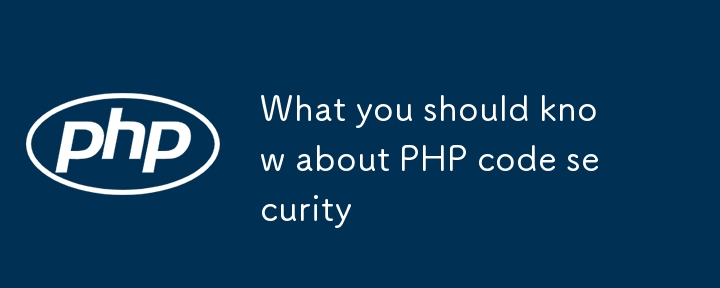

Web 開発に関して言えば、PHP は広く使用されているスクリプト言語です。 PHP の人気に伴い、PHP に関連する潜在的なセキュリティ リスクとそれらを軽減するための対策を理解することが重要です。 WordPress を使用して CMS アプリケーションをデプロイする場合でも、Laravel PHP フレームワークを使用してエンタープライズ アプリケーションを構築する場合でも、PHP セキュリティの重要性と、いくつかの注目すべき PHP インタープリターの脆弱性がビジネスに与える影響は、開発者にとって適切に対処することが重要です。
PHP のセキュリティ脆弱性から保護することが重要なのはなぜですか? PHP は人気があり、広く使用されているため、ハッカーや悪意のある組織の標的になることがよくあります。不適切なコーディング方法、ユーザー入力のサニタイズ不足、バージョンの古いなど、さまざまな理由により、セキュリティの脆弱性が忍び込む可能性があります。
たとえば、サニタイズされていないユーザー入力が SQL クエリで使用されるシナリオを考えてみましょう。これは、一般的な脆弱性である SQL インジェクションにつながる可能性があります。
$id = $_GET['id']; $sql = "SELECT * FROM users WHERE id = $id";
指定されたコードでは、悪意のあるユーザーが URL 内の id パラメータを操作して SQL インジェクションを実行できます。これを防ぐには、mysqli_real_escape_string または準備されたステートメントを使用するなど、ユーザー入力をサニタイズすることが重要です:
$id = mysqli_real_escape_string($conn, $_GET['id']); $sql = "SELECT * FROM users WHERE id = $id";
PHP アプリケーションのセキュリティの脆弱性は、ビジネスに重大な影響を与える可能性があります。これらはデータ侵害につながる可能性があり、GDPR や CCPA などのデータ保護規制への違反により高額の罰金が科せられる可能性があります。侵害は顧客の信頼を損ない、ビジネスの損失につながる可能性もあります。さらに、脆弱性を修正するための修復コストは、特に開発ライフサイクルの後半で脆弱性が発見された場合に高額になる可能性があります。そのため、プロジェクトの開始時からセキュリティを優先することが重要です。
ユーザー入力を常に検証し、サニタイズします。 SQL インジェクションを防ぐには、パラメータ化されたクエリでプリペアド ステートメントを使用します。 PHP とそのフレームワークには既知の脆弱性に対するセキュリティ パッチが付属しているため、最新バージョンを使用してください。 Snyk などのツールを定期的に使用して、コードとアプリケーションの依存関係、およびクラウド インフラストラクチャ構成の脆弱性をスキャンします。安全なコーディング慣行に従ってください。
脆弱な PHP アプリケーションはデータ侵害、顧客の信頼の喪失、規制上の罰金につながる可能性があるため、PHP のセキュリティは非常に重要です。 PHP は Web アプリケーションの開発によく使用されるため、攻撃者の標的になることがよくあります。 PHP コードの安全性を確保することは、ユーザーのデータとビジネスを保護するのに役立ちます。
PHP 脆弱性スキャナーは、PHP コードを自動的にスキャンして既知のセキュリティ脆弱性を見つけるツールです。例には、Snyk および Composer の組み込みセキュリティ チェッカーが含まれます。これらのツールは、PHP アプリケーションのセキュリティ問題を特定して修正するのに役立ちます。
PHP セキュリティ アドバイザリは、PHP コンポーネントのセキュリティ脆弱性に関する公的発表です。脆弱性、その潜在的な影響、およびその修正方法についての詳細が提供されます。 PHP.net およびその他の PHP 関連 Web サイトでは、これらのアドバイザリが公開されることがよくあります。 Snyk は、Composer パッケージ マネージャーに基づいた PHP セキュリティ アドバイザリのデータベースも管理しています。
いくつかの一般的な PHP セキュリティ脆弱性を調査し、それらを軽減するために役立つ開発者セキュリティ リソースについて学びましょう。
Cookie とセッションは、リクエスト間の状態を維持できるようにする Web 開発の基本的な側面です。ただし、正しく管理しないと、重大なセキュリティ上の欠陥が発生する可能性があります。
PHP では、特に Laravel などの Web フレームワークを使用する場合、認証を管理するときに Cookie とセッション データを保護することが重要です。ここにいくつかのヒントがあります:
Laravel では、config/session.php ファイルで次の構成を設定できます。
'cookie' => env(
'SESSION_COOKIE',
Str::slug(env('APP_NAME', 'laravel'), '_').'_session'
),
'cookie_secure' => env('SESSION_SECURE_COOKIE', null),
'cookie_same_site' => 'lax',
PHP セキュリティの脆弱性から保護するために、Laravel アプリケーションの保護に関する詳細な Web セキュリティ ガイドラインを参照してください。
SQL インジェクションは、攻撃者が Web アプリケーションのデータベース クエリの脆弱性を悪用するために使用するコード インジェクション手法です。機密データへの不正アクセスや、データの操作や削除につながる可能性があります。
次の脆弱な PHP コードについて考えてみましょう:
$id = $_GET['id']; $result = mysqli_query($con, "SELECT * FROM users WHERE id = $id");
An attacker can manipulate the id parameter in the URL to alter the SQL query. To prevent this, use prepared statements:
$stmt = $conn->prepare("SELECT * FROM users WHERE id = ?");
$stmt->bind_param("s", $_GET['id']);
$stmt->execute();
For more on SQL injection and PHP security, check out this free PHP security education.
Code injection is another common vulnerability where an attacker can inject and execute arbitrary code within your application. In PHP, this often occurs when user input is passed into the eval() function or system calls without proper validation or sanitization.
Let's consider the following use case in the context of a PHP Laravel project, where a developer faced a challenge while attempting to dynamically generate an image URL within a Blade template. The goal was to display an image whose path was constructed using variable content and Laravel's URL helper function. To achieve this, the developer used PHP's eval() function as follows:
php
eval("\$image_url = \"{{ url('public/uploads/trust/".$value.".jpg') }}\";");
?

The developer's intention was to create a flexible way to generate image URLs based on the $value variable. However, the use of eval() raises significant security concerns, such as:
The developer could have used a more secure and maintainable approach by using Laravel's Blade templating engine to generate the image URL:
 }})
This method avoids the use of eval() altogether, leveraging Laravel's built-in functionalities to securely generate dynamic content. Make sure you read about more ways to prevent PHP code injection.
One often overlooked area of application security is third-party dependencies. In PHP, we use Composer to manage these dependencies. It's crucial to regularly check your dependencies for known security vulnerabilities.
You can use tools like Snyk to automatically scan your Composer dependencies for known vulnerabilities. Here's how you can install and use Snyk:
npm install -g snyk snyk test
When running the snyk test command in the root directory to test your Composer dependencies for security vulnerabilities, you might see output like this:
Testing /path/to/your/laravel-project/composer.lock... ✗ High severity vulnerability found in symfony/http-foundation Description: Arbitrary Code Execution Info: https://snyk.io/vuln/SNYK-PHP-SYMFONY-174006 Introduced through: symfony/http-foundation@5.4.0 From: symfony/http-foundation@5.4.0 From: symfony/http-foundation@5.4.0 > symfony/http-foundation@5.4.0 From: symfony/http-foundation@5.4.0 > symfony/http-foundation@5.4.0 > symfony/http-foundation@5.4.0 From: symfony/http-foundation@5.4.0 > symfony/http-foundation@5.4.0 > symfony/http-foundation@5.4.0 > symfony/http-foundation@5.4.0 Fix: Upgrade to symfony/http-foundation@5.4.1 Tested 123 dependencies for known vulnerabilities, found 1 vulnerabilities, 122 vulnerable paths.
I highly recommend reading more on testing your PHP Composer dependencies for security vulnerabilities with Snyk.
Even if you follow secure coding practices, vulnerabilities in the PHP interpreter itself can expose your applications to risks. For instance, multiple vulnerabilities were reported in the Debian PHP8.2 package, which you can view in the Snyk database.
Some of the notable PHP interpreter vulnerabilities include:
These vulnerabilities could allow an attacker to execute arbitrary code or cause a DoS (Denial of Service). So, it is essential to keep your PHP version updated and frequently check for any reported vulnerabilities in the PHP interpreter you are using.
Snyk is a powerful developer-first security platform that helps developers identify and fix security vulnerabilities in their PHP applications. It provides an extensive database of known vulnerabilities and can automatically scan your project for these issues. Snyk also offers automated fix PRs, which can save developers significant time in fixing identified vulnerabilities.
There are several common PHP vulnerabilities that developers should be aware of. These include:
One way to stay updated on PHP interpreter vulnerabilities is to connect your Git repositories to Snyk, which will automatically monitor your dependencies for vulnerabilities and notify you of any new vulnerabilities that are reported. Specifically, you might be deploying your PHP applications using Docker and other containerization technology, and it's crucial to monitor your container images for vulnerabilities because these Docker container images bundle the PHP interpreter and other dependencies that could be vulnerable.
If you're using Docker, you can use Snyk to scan your Docker container images for known vulnerabilities by running the following:
snyk container test your-docker-image
Make sure to follow James Walker's best practices for building a production-ready Dockerfile for PHP applications and Neema Muganga's Securing PHP Containers guide to secure your PHP container images.
Protecting against PHP security vulnerabilities should not be an afterthought but an integral part of your development process. It involves secure coding practices, regular updates, and vigilance for any reported vulnerabilities in the PHP ecosystem.
To learn more about PHP security, you can follow online tutorials on the Snyk blog and take free online byte-sized lessons on Snyk Learn. Websites like OWASP also provide extensive resources on web application security, including PHP.
以上がPHP コードのセキュリティについて知っておくべきことの詳細内容です。詳細については、PHP 中国語 Web サイトの他の関連記事を参照してください。